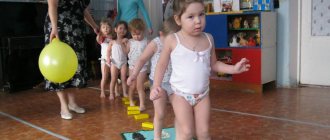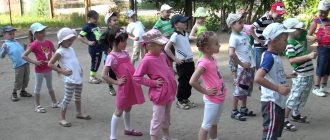Complexes of general developmental exercises in the younger group
Nelly Rutskova
Complexes of general developmental exercises in the younger group
Complex No. 1 (handkerchiefs)
.
1."Play with a handkerchief"
.
I. p. O. s., handkerchief in the right (left)
hand below. B. Raise the handkerchief up and lower it to the floor. Bend over and pick up the handkerchief. Breath
arbitrary. (4–6 times)
.
2."Move the handkerchief"
.
I. p. O. s., arms to the sides, handkerchief in the right hand. B. 1 – extend your arms forward, transfer the handkerchief to your left hand (exhale)
;
2 – spread your arms to the sides (inhale)
;
3 – extend your arms forward, transfer the handkerchief to your right hand (exhale)
;
4 – i. p. (inhale)
. 4–6 times.
3."Hide behind a handkerchief"
.
I. p. Standing, handkerchief below in both hands. V. 1 – sit down, handkerchief in front of your face (hid)
exhale; 2 – i. n. inhale. 4–6 times.
5."Jumping"
. I. p Standing, the handkerchief lies on the floor in front of you. Jumping in front of a handkerchief, alternate with walking. Breathing is voluntary. 2 times.
6. “Breeze” ( breathing exercise )
. I. p O. s., hands with a handkerchief in front of him. B. Blow on a handkerchief. 2 – 4 times.
Complex No. 2 (without items)
.
1."Stretch"
. I. p. O. s., hands below. B. 1 – rise on your toes, arms up through your sides, inhale. 2 – return to i. n. exhale. 4–6 times.
2."Pendulum"
.
I. p. Feet shoulder-width apart, hands on the belt. B. Tilt the head to the right (left)
side, inhale. 4–6 times.
3."Doll"
. I. p. O. s., arms along the body. B. Raise your right shoulder up, and. p., raise your left shoulder up, and. p., inhale. 4–6 times.
4."Tumbler"
. I.p. Sitting on the floor, legs pulled together, clasp your legs with your hands. B. Rolls to the right, left. Breathing is voluntary. 4–6 times.
5."Top"
. I. p. Legs are foot-width apart, parallel. B. Jumping on two legs, alternate with walking. Breathing is voluntary. 2 times.
6. “I’ll grow big” ( breathing exercise )
.AND.
p. O. s. B. 1, 2 – raise your arms up, stretch well; 3, 4 – lower your arms down, lower yourself onto your entire foot, say “U-u-u!”
.2 – 4 times.
Complex No. 3 (medium ball)
.
1."Look at the ball"
.AND.
p. O. s. , the ball is below in both hands. B. 1 – rise on your toes, lift the ball above your head, inhale; 2 – return to i. p., say “down”
, exhale. 4–6 times.
2."Pass the ball"
.AND. p. Feet width apart, arms to the sides, ball in the right hand. B. 1 – extend your arms forward, transfer the ball to your left hand, exhale; 2 – spread your arms to the sides, inhale; 3 – extend your arms forward, transfer the ball to your right hand, exhale; 4 – i. n. inhale. 4–6 times.
3."Roll the ball"
.AND.
p. Sit legs crossed, ball on the right (left)
side on the floor. B. Roll the ball to the right and left sides in front of you. Breathing is voluntary. 4–6 times.
4."Play with the ball"
.AND. p.O.S., ball in front of the chest. B. Throwing the ball up. Breathing is voluntary. 4–6 times.
5."Jumping"
.AND. n. Feet width apart, ball in front of you. B. Jumping on two legs with a ball in hands. Alternate with walking. Breathing is voluntary. 2 times.
6. “Show the ball”
(
breathing exercise ) .I.
p. O. s. ,ball in front of chest. B. 1, 2 – take a deep breath; 3, 4 – make your lips a tube, exhale calmly, extend your hands with the ball forward (show the ball)
. 2 – 4 times.
Complex No. 4 (without items)
.
1."Look Around"
.AND. r Feet shoulder-width apart, hands on the waist. B. Turns the head to the right and left sides. 2 times.
2."Pick an Apple"
.AND. r Feet width apart, arms along the body. B. 1 – rise on your toes, raise your right hand up (pick an apple, exhale; 2 – i.p. inhale;
3 – rise on your toes, raise your left hand up, exhale;
4 – i. n. inhale. 3 times.
3."Flower"
.AND.
n. Squatting, hug your knees with your hands. B. Straighten up, stand on your toes, raise your arms up (the flower has blossomed)
. Breathing is voluntary. 4–6 times.
4."Glomerulus"
.
I. p Lying on your back, legs straight, arms along the body. B. Pull your knees to your stomach, clasp your arms, press your head to your knees (curl into a ball)
.
Breathing is voluntary. 4–6 times.
5."Bell"
.AND. p O. s. , arms are bent at the elbows. B. Jump legs apart, arms to the sides. Alternate with walking. Breathing is voluntary. 2 times.
6. “Hedgehog”
(
breathing exercise ) .I.
p. O. s., hands on the belt. B. Look to the right (left, take a deep breath. Look straight, say: “F - f - f
.” 2 - 4 times.
Complex No. 5 (cubes)
.
1."Knock the cube against the cube"
. I. p Feet width apart, arms with cubes along the body. B. Raise your hands with the cubes up through your sides and hit them against each other. Return to i. n. Breathing is voluntary. 4–6 times.
2."Hit the cubes on your knees"
.AND.
n. Feet at the width of the foot, hands with cubes on the belt. B. Bend over, tap the cubes on your knees, say: “Knock, knock.”
Breathing is voluntary. 4–6 times.
3."Knock the cubes under your knees"
.AND. p. Sitting on the floor, arms with cubes bent at the elbows. B. Raise your legs up, hit the cubes under your knees. Breathing is voluntary. 4–6 times.
4."Put and Take"
.AND. p. Legs slightly apart, arms with cubes behind the back. B. 1 – sit down, put the cubes on the floor, exhale;
2 – i. n. inhale;
3 – sit down, take the cubes from the floor, exhale;
4 – i. n. inhale. 4–6 times.
5."Jumping with cubes"
.AND. p.O.s., arms with cubes bent at the elbows. B. Jump legs apart, arms with cubes to the sides. Alternate with walking. Breathing is voluntary. 2 times.
6. “Blowing on the cubes”
(
breathing exercise ) .I. p.O.S., hands with cubes in front of the chest. B. The cubes lie on the palms, blow on the cubes. 2 – 4 times.
Complex No. 6 (without items)
.
1."Watch"
.AND. n. Feet width apart, hands on the belt. B. Turn your head to the right (to the left, return to i.p. Breathing is arbitrary. 4–6 times.
2."Strongmen"
. I. p. Feet shoulder-width apart, arms to the sides. B. Bend your arms to your shoulders, clench your fingers into a fist. Breathing is voluntary. 4–6 times.
3."Woodcutter"
.AND.
p. Legs slightly apart, arms raised above the head and clasped into a fist. B. 1 – lean forward, say “Uh”
; 2 – and. n. inhale; 4–6 times.
4."Birds are pecking"
.AND. p. O. s. , hands are lowered behind the back. B. Sit down, tap your knees with your fingers, exhale. 4–6 times.
5. Jumping. I. p. O. s. B. Jumping legs apart, hands on the belt. Alternate with walking.
Breathing is voluntary. 2 times.
6. “Ah”
(
breathing exercise ) .I.
p. O. s., hands on the belt. B. Inhale, hold your breath. Exhaling, say: “A – a – a – a – ah!”
. 2 – 4 times.
Complex No. 7 (leaves)
.
1."Play with the leaves"
.AND. n. Legs feet-width apart, arms with leaves along the body. B. 1 – lift the leaves forward; 2 – up; 3 – wave; 4 – and. n. Breathing is voluntary. 4–6 times.
2."Wavings"
.AND.
p. O. s., hands with leaves on the belt. B. Simultaneously swing the right (left)
hand up and the left
(right)
hand down. Breathing is voluntary. 4–6 times.
3."Put and Take"
.AND. p. Legs apart, hands with leaves on the belt. B. 1 – sit down, put the leaves on the floor, exhale; 2 – and. n.;3 – sit down, take leaves from the floor, exhale;4 – i. n. 4–6 times.
4."Turn around"
.AND. p. Legs slightly apart, hands with leaves behind the back. B. Spin to the right (to the left, hands with leaves to the sides. Breathing is arbitrary. 2 times.
5."Jumps"
. I. p. O. s., arms with leaves bent at the elbows. B. Jumping from foot to foot. Alternate with walking. Arbitrary. 2 times.
6. “Let’s blow on the leaves”
(
breathing exercise ) .I. p. O. s., hands with leaves in front of the chest. The leaves lie on the palms, blow on the leaves. 2 – 4 times.
Complex No. 8 (without items)
.
1."Tick-tock"
. I. p. Legs slightly apart, hands on the belt. B. Tilt your head to the right (to the left, return to i.p. Free 4-6 times.
2."Rattles"
.AND. p.O.S., hands behind back. B. Clench your fingers into a fist, raise your hands up, shake your fists. Arbitrary. 4–6 times.
3."Teremok"
.AND. n. Feet width apart, palms of hands connected in front of chest. B. Turn your torso to the right (to the left, spread your arms to the sides. Exhale. 4-6 times.
4."Parsley"
.AND.
n. Sitting on the floor, legs apart, arms supported behind. B. Raise your right (left)
leg up, tilt your head towards your leg. Arbitrary. 3 times.
5."Ball"
. I. p. O. s., hands on the belt. B. Jumping on both legs, hands on the belt. Alternate with walking. Arbitrary. 2 times.
6. “I will grow big”
(
breathing exercise ) .I.
p. O. s. B. Raise your arms up, stretch well, rise on your toes; And. etc., say “u-u-u”
.2 – 4 times.
Complex No. 9 (flags)
.
1."Signalers"
. I. p. Legs feet-width apart, arms with flags along the body. B. 1 – raise the flags to the sides; 2 – up; 3 – forward; 4 – i. n. Arbitrary 4–6 times.
2."Knock"
. I. p. O. s., hands with flags on the belt. B. Sit down and knock the flags on the floor. Exhalation. 4–6 times.
3."Aircraft"
.AND. p. Legs apart, hands with flags behind the back. B. Lean forward, spread your arms to the sides. Exhalation. 4–6 times.
4."Turn around"
.AND. p. Legs slightly apart, hands with flags in front of you. B. Spin to the right (to the left, arms with flags to the sides. Free. 2 times.
5."Jumps"
.AND. p.O.S., arms with flags bent at the elbows. B. Jumping from foot to foot. Alternate with walking. Arbitrary. 2 times.
6. “Let’s blow on the flags”
(
breathing exercise ) .I. p.O.S., hands with flags in front of the chest. B. Inhale, blow on the flags. 2 – 4 times.
Complex No. 10 (without items)
.
1."Surprising"
.AND. p. O. s., hands on the belt. B. 1 – raise your shoulders up; Inhale, 2 – lower your shoulders down. Exhalation. 4–6 times.
2."Swimmer"
.AND.
n. Feet shoulder-width apart, arms along the body. B. Raise your right (left)
arm through the sides, move it forward, spread your body to the left, lower your arms down, return to i. n. Arbitrary. 4–6 times.
3."Hide"
.AND. n. Legs slightly apart, hands behind back. B. Perform squats, touch your forehead to your knees and hug them with your hands, exhale. I. p. 4–6 times.
4."Bug"
.AND. n. Lying on your back, arms along the body. B. Raise your legs and arms and dangle them in the air. Arbitrary. 3 times.
5."Jumping"
. I. p. Legs together, hands on the belt. B. Jumping forward and backward. Alternate with walking. Free 2 times.
6. “Stretch”
(
breathing exercise ) .
I. p. Legs slightly apart, arms along the body. B. Raise your arms up through your sides, stretch well. Bend over and, as you exhale, say: “Wow!”
.2 – 4 times.
Complex No. 11 (hoop)
.
1."Look at the hoop"
.AND.
p. O. s., hoop at the bottom, girth from the sides. B. Raise the hoop up, stretch, look at it, return to i. p., say “down”
. Arbitrary. 4–6 times.
2."Turns"
.AND. p. O. s., hoop in front of the chest. B. 1 – turn to the right, inhale; 2 – i. p. ;3 – turn to the left, inhale; 4 – i. p. 3 times in each direction.
3."Show me the hoop"
.
I. p. Legs wider than shoulders, hoop in front of you. B. Lean forward, stretch your arms forward - up, head straight to “show”
the hoop. Exhalation. 4–6 times.
4."Squat"
.AND.
n. Feet width apart, hoop in front of you. B. Sit down, stretch your arms forward, say: “Sit down!”
, return to and. n. Arbitrary. 4–6 times.
5."Jumping"
.AND. p. Standing in a hoop, feet together. B. Jumping in a hoop. Alternate with walking.
Arbitrary. 2 times.
6. Walking on a hoop. I. p. Standing on a hoop. B. Walking on a hoop. Arbitrary. 2 times.
Complex No. 12 (without items)
.
1."Compromisers"
.AND. p. O. s., hands on the belt. B. Tilts the head back and forth. Inhale - exhale. 4–6 times.
2."Pull - Push"
.AND. p. O. s., right hand forward, left hand bent at the elbow, palms forward. B. Alternating right and left hands. Arbitrary. 4–6 times.
3."Drummer"
.AND.
n. Feet shoulder-width apart, hands behind your back below. B. Bend over and tap your index fingers on your knees and say: “Ta-ta-ta!”
Arbitrary.
4–6 times.
4."Glomerulus"
.
I. p. Lying on your back, legs straight, arms along the body. B. Pull your knees to your stomach, clasp your arms, press your head to your knees (curl into a ball)
.
Arbitrary. 4–6 times.
5."Jumping"
.AND. n. Legs together, hands on the belt. B. Jumping forward and backward. Alternate with walking. Arbitrary. 2 times.
6. “I will grow big”
(
breathing exercise ) .I.
p. O. s. B. Raise your arms up, stretch well, rise on your toes; return to i. etc., say “u-u-u”
.2 – 4 times.
Complex No. 13 (without items)
.
1."Show your hands"
.AND.
n. Legs slightly apart, hands behind back. B. Stretch your arms forward (show your hands)
. Exhale. 4–6 times.
2."Spinner"
.AND. p. O. s., arms moved to the sides. B. Turns the body to the right - left.
Arbitrary. 4–6 times.
3."Small big"
.AND.
n. Sit down with your hands clasping your knees (we are small)
.V.
Stand up, stretch your arms up (we are big)
. Free exercise. 4–6 times.
4."Rocking chair"
.AND. n. Lying on your back, legs bent, knees pressed to your chest. B. Wrap your hands around your knees, press your head to your knees, rock forward and back on your back. Arbitrary. 4–6 times.
5."Athlete"
. I. p. O. s. B. Run quickly in place, raising your knees high. Alternate with walking. Free 2 times.
6. “Wind”
(
breathing exercise ) .I. p. O. s., hands on the belt. B. 1, 2 – take a deep breath;
3, 4 – make your lips a tube, do not exhale quickly. 2 – 4 times.
Complex No. 14 (big ball)
.
1."Look at the ball"
.AND.
p. O. s., ball below, girth from the sides. B. Raise the ball up, stretch, look at it, return to i. p., say “down”
. Arbitrary. 4–6 times.
2."Turns"
.AND. p.O.S., ball in front of the chest. B. 1 – turn to the right; inhale, 2 – and. P. ;
3 – turn to the left; inhale, 4 – and. p. 3 times in each direction.
3."Show me the ball"
.AND.
n. Feet wider than shoulders, ball in front of you. B. Lean forward, stretch your arms forward, head straight to “show”
the ball. Exhalation. 4–6 times.
4."Squat"
.AND.
n. Feet width apart, ball in front of you. B. Sit down, extend your arms with the ball forward, say: “Sit down!”
, return to and. n. Arbitrary. 4–6 times.
5."Jumping"
.AND. n. Ball in both hands. B. Jumping from one foot to another. Alternate with walking.
Arbitrary. 2 times.
6. “Show the ball”
(
breathing exercise ) .
I. p. O. s., ball in front of the chest. B. 1, 2 – take a deep breath; 3, 4 – make your lips a tube, exhale calmly, extend your hands with the ball forward (show the ball)
. 2 – 4 times.
Complex No. 15 (without items)
.
1."Spindle"
.AND. n. Feet shoulder-width apart, hands on the belt. B. Circular movements of the head to the right and left. Free 2 times.
2."Locomotive"
.AND.
p.O.S., arms bent at the elbows. B. Raise and lower your shoulders, performing circular movements with your arms, saying: “Chuh - chuh!”
.Freedom 4–6 times.
3."Pump"
.AND.
p.O.S., feet shoulder-width apart, hands below. B. Tilt the torso to the right (to the left, hands slide along the body, saying: “S - s - s!”
. Arbitrary. 4-6 times.
4."Bug"
.
I. p. Lying on your back, legs bent at the knees. V. Flounder, like “a beetle has fallen and cannot get up.
He is waiting for someone to help him.” Free exercise 4–6 times.
5."Ball"
. I. p. O. s., hands on the belt. B. Jumping on both legs. Alternate with walking.
Free 2 times.
6. “I will grow big”
(
breathing exercise ) .I.
p. O. s. B. Raise your arms up, stretch well, rise on your toes; Return to i. etc., say “u-u-u”
.2 – 4 times.
Complex No. 16 (rattles)
.
1."Play with rattles"
.AND. p. Legs slightly apart, hands with rattles below. B. Raise your hands up and play with rattles. Free 4–6 times.
2."Show me the rattles"
.AND.
n. Legs wider than shoulders, hands with rattles below. B. Lean forward, stretch your arms forward – up, head straight “show”
the rattles.
Exhale 4–6 times.
3."Tilts"
.AND.
p. Sitting legs crossed, hands with rattles on the belt. B. Tilts the body to the right (to the left, hands slide along the body, right (left)
up. Inhale
2 times.
4."Squats"
.AND.
n. Feet width apart, hands behind your back. B. Sit down, extend your arms with rattles forward, say: “Sit down!”
Exhale 4–6 times.
5."Jumps"
. I. p. O. s., hands with rattles in front of the chest. B. Jumping on both legs. Alternate with walking. Free 2 times.
6. “Let’s blow on the rattles”
(
breathing exercise ) .I.
p. O. s. Raise your arms up, stretch well, rise on your toes; Return to i. etc., say “u-u-u”
.2 – 4 times.
Complex No. 17 (without items)
.
1."Stretch"
.AND. p.O.S., hands below. B. 1 – rise on your toes, arms up through your sides; Inhale, 2 – return to i. n. Exhale 4–6 times.
2."Swimmer"
.AND.
n. Feet shoulder-width apart, arms along the body. B. Raise your right (left)
arm through the sides, move it forward, spread your body to the left, lower your arms down, return to i. n. Free 4–6 times.
3."Pump"
.AND.
p.O.S., feet shoulder-width apart, hands below. B. Tilt the torso to the right (to the left, hands slide along the torso, saying: “S - s - s!”
. Arbitrary 4-6 times.
4."Birds are pecking"
. I. p. O. s., hands behind the back. B. Sit down and tap your knees with your fingers. Free 4–6 times.
5."Ball"
. I. p. O. s., hands on the belt. B. Jumping on both legs. Alternate with walking.
Free 2 times.
6. “I will grow big”
(
breathing exercise ) .I.
p. O. s. Raise your arms up, stretch well, rise on your toes; Return to i. etc., say “u-u-u”
.2 – 4 times.
What is it and how to do it correctly?
A child of 3–4 years old must constantly move in order to develop normally. To ensure that this activity has some purpose, you can use the outdoor games included in the exercise. Starting the day every day through exercise instills a certain level of organization in the child, cultivating the right qualities in him. In addition, after some time, the baby will truly enjoy sports activities. Using morning exercises allows you to calm down hyperactive children with a set of exercises and increase the activity of those who prefer to sit quietly and play alone.
Regular exercises at home and in kindergarten help children become more resilient, gain the first skills of self-discipline and endurance. The advantage of kindergarten classes is year-round work, which in the warm season is carried out in the fresh air, which is even more useful, whereas at home there is not always such an opportunity. With the help of properly selected exercises, the preschooler receives a dosed load on the muscles, which allows them to grow and develop properly. In addition, the heart and lungs are actively working, which makes it possible to identify any deviations at an early stage or prevent them altogether.
The optimal time for exercise at this age is from 8 to 15 minutes, during which you can cheer up and prepare for the day ahead. It is important to monitor the strength of the load and the complexity of the exercises so that they are not too difficult or easy. When carrying out exercises with children 3 years of age and older, it is important to organize the process so that all participants are equally interested, and this is only possible with the help of games. In the kindergarten, the following is carried out in this way:
- sports;
- musical;
- general education classes.
In order for any activity to be to the liking of children, it is important to organize it correctly, for which you need:
- prepare active music that will delight children and motivate them to do physical exercise;
- find exercises that will be interesting and fun for the child to do, where he himself will strive to repeat and increase the number of repetitions;
- use unusual names for tasks to intrigue the child;
- for parallel development of speech, hearing and rhythm, you can sing or read poetry during exercises;
- An interesting option would be a video lesson where children of a similar age do exercises;
- It is important to monitor the quality of each element during exercise so that they have the maximum effect, for which the adult should praise and encourage the child.
With the help of the right motivation, an interesting set of tasks, and cheerful music, you can create in children a strong desire to do exercises every day, while experiencing exclusively positive emotions.
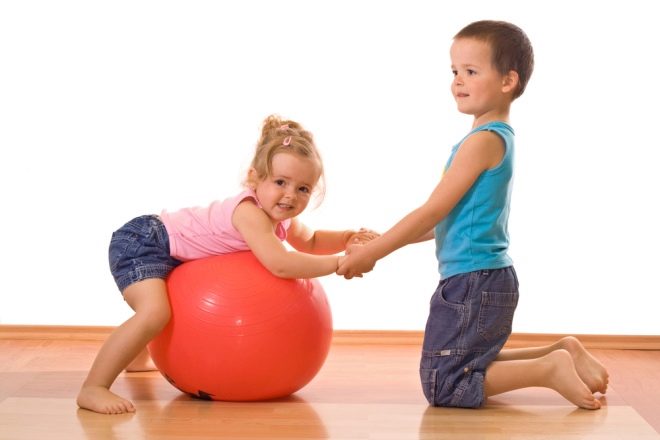
Types of gymnastics
Among the sets of exercises for preschool children, there are several types of gymnastics, which can be divided into therapeutic, applied, general developmental and sports.

Note! The main goal of exercise for a 3-year-old child should be a variety of exercises; they can be performed to music so that the child has fun. Pediatricians recommend taking a gymnastics course for a child with his mother from E. Zheleznova.
Let's consider several types of gymnastics for a child aged three:
| Type of gymnastics | Description |
| Artistic | Exercises to music using additional equipment that develop flexibility - suitable for girls |
| Finger | Moving gymnastics for arms and legs, switching the baby’s attention, developing coordination and fine motor skills, usually in verse |
| Articulatory | Exercises that develop the mobility of the lips and tongue, teaching the accuracy of the posture of the lips and facial muscles |
| Exercise therapy | Helps with certain disorders, such as dysplasia, and is also used as therapeutic prophylaxis |
| Respiratory | Teaches the child the correct inhalation and exhalation, forms ventilation of the lungs. Breathing exercises allow you to listen to your body |
| Speech therapy | This gymnastics is suitable for the tongue: a child who has problems with speech after such exercises acquires normal articulation |
| Wellness | This includes a set of the above methods combined into one charge. |
The importance of physical education for children 3 years old
By the age of 3, a child’s body enters a phase of active development. During this period, the baby can already independently choose the direction of movement, demonstrate the ability to move quickly and run short distances.
Despite the fact that at this age children are not yet able to concentrate on classes and it is difficult to keep their attention, they love active games and dynamic exercises. Activities that are conducted in a playful manner simultaneously have a positive effect on the child’s health, fitness, and general mood.
When and how to do it?
Children's gymnastics is carried out in the form of a game. For the lesson you need to prepare dynamic music. Doing exercises with sound is not only fun, but also useful. Music helps maintain rhythm and develops hearing. You can also choose interesting names for the movements (for example, “now do like a fish,” “be a little monkey and pick a banana”). Another option is to conduct gymnastics classes accompanied by poems (an example of a poetic set of exercises awaits you below).
What rules must be followed when charging?
- The air in the room should be fresh. In summer it is better to move the activity outside.
- You need to do the exercises in the morning, in the interval between hygiene procedures and breakfast. As a last resort, you can do gymnastics 40-60 minutes after eating.
- An adult should ensure that when performing exercises the child inhales through the nose and exhales through the mouth.
- If the baby is 3-4 years old, the duration of home gymnastics should not exceed 15 minutes. It is optimal to do exercises for about 10 minutes so that the activity is beneficial and does not get boring.
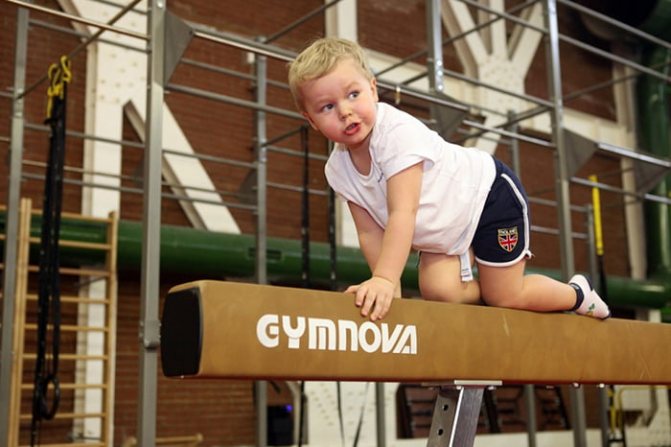
Prevention of flat feet
To prevent flat feet, do foot exercises.
◈ Sit your baby on the floor and invite him to be a monkey. Scatter various (small) objects around and ask the baby to collect them with his toes. Show me how to do it. The task will not be easy!
◈ Sit on the floor (on a soft surface) opposite each other, hold a towel (or clothing) between your legs and play tug of war.
◈ Sit on the floor, pass the ball to each other, pushing it with your feet.
◈ Let the baby raise his arms up, stand on his toes and walk several circles around the room. This exercise trains the muscles of the lower leg and foot well.
Let's move to the songs
If desired, any children's song can be used as musical accompaniment, as well as prompts for action when performing exercises. For example, this one:
Ah, in Africa the mountains are so high (we raise our hands up)
Ah, in Africa the rivers are this wide, (we raise our arms to the sides)
Ah, crocodiles, hippos, (clap our hands)
Ah, monkeys, sperm whales,
Oh, and a green parrot (we wave our arms like birds)
- The benefits of gymnastics
The obvious benefits of sports indicate that gymnastics is necessary for a child at any age, especially at 3 years old.
It is a complex of acrobatic exercises and dance elements performed to music.
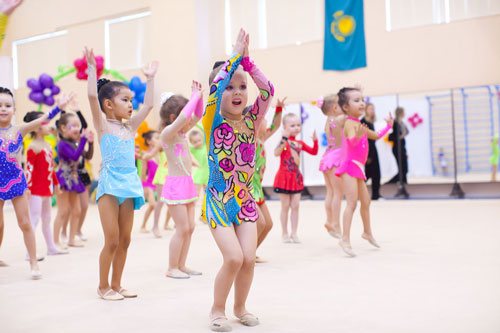
In addition, it is divided into several types, which will be discussed in the next section. Movements in gymnastics are active, dynamic, and additional equipment is often used: ribbons, hoops, balls.
Let's consider the benefits of developmental gymnastics for children 3 years old:
- Physical activity promotes the proper development of the baby’s muscles and bones, in addition, correct posture is formed and the level of health increases.
- There is a development of plasticity and the motor system.
- While in the gymnastics section, the child involuntarily develops the skill of communication and interaction with peers.
- Classes help awaken a sense of responsibility and develop strong-willed spirit and competition.
- Fun exercises help children feel the music and express their mood through movement.
The development of flexibility, dexterity, orientation in space - all this is provided by gymnastics. You should not send your child to the section if he strongly opposes it.
It is necessary to demonstrate a set of exercises to him at home several times to see his desires.
Important! For children 3 years old, it is better to choose a less traumatic form of gymnastics: the muscles are not yet fully formed, which will lead to their deformation.
Systematic performance of gymnastic exercises promotes self-discipline, allows you to properly organize time and gives pleasure.
Exercises for children to strengthen the muscles of the whole body
Merry path
A child crawls on all fours on a bench. This could be a “bridge” across a river or a “magic road” to grandma. Be sure to insure your child.
Wheelbarrow
The child lies on the floor, resting his hands. An adult holds the child by the legs, lifting them from the floor to a height comfortable for the child. The child moves his hands forward and backward.v
Turtle
The child lies on his back with his arms extended along his body. Then he pulls his knees to his chest with his hands and tries to touch his knees with his head. You can sway back and forth in this position - this is the turtle hiding in its shell.
